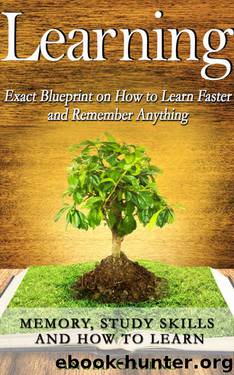Learning: Exact Blueprint on How to Learn Faster and Remember Anything - Memory, Study Skills & How to Learn (Accelerated Learning, Memory Improvement, Studying, Learning Techniques, Brain Training) by Angel Greene

Author:Angel Greene [Greene, Angel]
Language: eng
Format: epub
Published: 2015-09-05T06:00:00+00:00
Chapter 12: Reading For Learning
We all know that reading is an imperative for learning in most cases, especially in school. Personally, I’ve learned so much since graduating through reading books and articles. Unlike going to classes at particular hours and having to adjust to the teaching pace, reading books and other materials offer the convenience of being able to learn at your convenient time and convenient pace. You don’t adjust to the classes, the “classes” adjust to you.
Reading for optimal learning isn’t as simple as, well, just reading. There is a systematic way of reading materials for accelerating your learning experience – the SQR3 technique. SQR3 stands for Survey, Question, Read, Recite and Review and is a good technique created to help improve reading recollection through different and repeated ways of engaging the material.
One key to memorizing something is repetition – the frequency of our engagement with something determines just how deep into our long-term memory it can sink. Some students go through their assigned readings two times to be familiarize themselves well with the material.
But as much as repetition helps us learn something, reading for optimal learning requires that such repetition also be systematic or methodical, i.e., there should be a method to the madness. One systematic reading technique was already discussed – summarizing. Another is the SQR3 technique. Let’s take a closer look at the 5 important parts of this technique.
SURVEY
In this first step, you read the material simply by surveying it in order to get a general picture of overview. This step is also referred to as skimming or scanning. The reason behind this first step is that our minds prefer seeing the bigger picture in which to fit the individual parts together and see the general direction of the materials’ authors for deeper learning and understanding. Having an insight of the sequence, arrangement and structure of reading materials give us the opportunity to create a mental framework from which we can build our learnings around.
If we know, for example, that a particular reading material’s author is constructing a cause and effect reasoning, we can anticipate that he or she will discuss at least one cause followed by an enumeration of the effects of such cause.
It may be challenging to do this for relatively voluminous reading materials such as a monograph or a whole book. For these kinds of materials, it’ll be beneficial to create a visual representation of the material’s content. One useful tool – also discussed earlier – is the idea or mind map, which can help us monitor where we are mentally in terms of the discussion or argument flow. The idea map will also be particularly useful if the material is just borrowed and you need to return it soon – the diagram you created can help you find the ideas you’re looking quickly and easily reacquire the discussion context.
So how do we survey reading materials? Well, it depends on the material. For books, here’s how to do it:
● Read our book’s blurbs
Download
This site does not store any files on its server. We only index and link to content provided by other sites. Please contact the content providers to delete copyright contents if any and email us, we'll remove relevant links or contents immediately.
| ASVAB | GED |
| GRE | NCLEX |
| PRAXIS | SAT |
| See more | Flash Cards |
| Study Guides | Study Skills |
| Workbooks |
Talking to Strangers by Malcolm Gladwell(13197)
The Compound Effect by Darren Hardy(8790)
Tools of Titans by Timothy Ferriss(8193)
Wonder by R. J. Palacio(7977)
The Lover by Duras Marguerite(7807)
A Court of Wings and Ruin by Sarah J. Maas(7627)
The Circle by Dave Eggers(7021)
Deep Work by Cal Newport(6857)
Kaplan MCAT General Chemistry Review by Kaplan(6853)
To All the Boys I've Loved Before by Jenny Han(5762)
Wiseguy by Nicholas Pileggi(5651)
The Body: A Guide for Occupants by Bill Bryson(4956)
1,001 ASVAB Practice Questions For Dummies by Powers Rod(4437)
Eat That Frog! by Brian Tracy(4414)
Cracking the GRE Premium Edition with 6 Practice Tests, 2015 (Graduate School Test Preparation) by Princeton Review(4207)
Pre-Suasion: A Revolutionary Way to Influence and Persuade by Robert Cialdini(4121)
Barron's AP Biology by Goldberg M.S. Deborah T(4082)
ACT Math For Dummies by Zegarelli Mark(3972)
Alive: The Story of the Andes Survivors by Piers Paul Read(3956)
